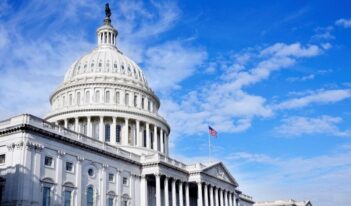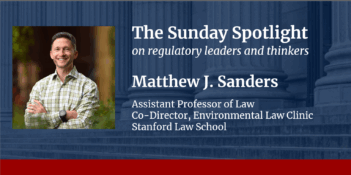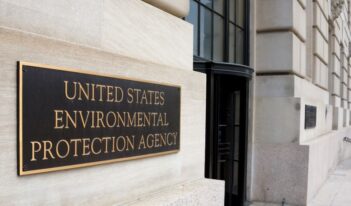
New study of EPA’s “flagship” performance program draws into question the value of voluntary efforts.
Since passage of most major environmental statutes in the 1970s and 1980s, environmental lawmaking at the federal level has ground to a virtual standstill. With today’s gridlock in Congress, the prospect appears dim of securing passage of new environmental legislation on climate change or other environmental concerns. For this reason, the U.S. Environmental Protection Agency (EPA) is pursuing a series of new regulations under existing statutes, principally the Clean Air Act. But the EPA’s regulatory authority only extends so far and cannot be used to address the full range of environmental impacts associated with business activity.
In the face of legislative gridlock and limits to administrative action, EPA has turned in recent decades to a strategy of voluntary environmental protection. The agency has launched dozens upon dozens of voluntary environmental programs aimed at encouraging companies to achieve levels of environmental performance still cleaner than required by law. We recently published an extensive study of EPA’s most celebrated and longstanding voluntary program, the National Environmental Performance Track, to see what insights this program might offer about what a voluntary approach to environmental quality can accomplish. Despite EPA officials trumpeting Performance Track as the agency’s “flagship” voluntary program, the program never achieved any demonstrable success.
EPA initiated its Performance Track program in 2000 following numerous high-level discussions about the need to create an alternative regulatory “track” for facilities committed to superior environmental performance. Agency officials theorized that if they could identify and reward the best facilities, they could encourage other businesses to do the same and they could also shift the EPA’s scarce enforcement resources to targeting truly troublesome facilities.
Although it sounded good in theory, the Performance Track concept actually struggled to gain traction and demonstrate success. Over its history, Performance Track received considerable criticism: environmental groups opposed its expansion, members of Congress questioned its cost, and even the agency’s own Inspector General concluded that it had failed to demonstrate achievement of its goals. As a result, soon after President Obama took office in 2009, then-EPA Administrator Lisa P. Jackson abruptly ended the program.
Even though Performance Track is now dead, the theory behind it continues to live on. Programs similar to Performance Track operate at EPA, the Department of Energy, and at the Occupational Safety and Health Administration. Some fifteen state environmental protection departments continue to run very similar programs. EPA’s experience with Performance Track can therefore still offer relevant lessons. Our recently published study represents the first, sustained academic analysis of how the program operated and what it could properly be said to have achieved.
To qualify for Performance Track’s rewards, a facility needed to have a clean compliance record, a third-party certified environmental management system, and goals for improving its environmental performance in ways that exceeded regulatory standards. Once admitted as a Performance Track “member,” a facility had to continue to sustain compliance and report to EPA annually on its progress toward meeting its goals. In exchange, EPA exempted the facility from routine compliance inspections and allowed it to forego some of the administrative burdens of traditional regulatory compliance. Perhaps most important, EPA publicly recognized a member facility as a “top performer.”
The program turned out to be far from selective. On average, EPA admitted about 75% of facilities that applied. These 75% of applicants who were admitted did have stronger environmental performance than the other 25%. But no one could ever say for sure that Performance Track members were above average compared with all similar facilities in their sector. The EPA did not collect information allowing it to compare applicants’ environmental performance to that of non-applicants. When the EPA Office of Inspector General randomly selected a sample of Performance Track members and compared them with their peers, it found some Performance Track facilities actually fared worse than average. Ultimately, EPA’s claims that Performance Track members were “top performers” had little basis.
What really distinguished the facilities that entered Performance Track? During the height of the program, we conducted interviews with managers at Performance Track facilities and a selected group of matching plants in the same sector. We also administered a large-scale survey of facilities that applied for membership and compared the results with a random sample of non-member plants in the sectors where most Performance Track members belonged. We found that Performance Track plants were indeed different from their peers. But what distinguished them was not their environmental performance; it was that they possessed a different set of internal characteristics.
Managers at Performance Track facilities received more support for participating in voluntary programs from their superiors. They viewed environmental protection as a priority, to be sure, but they also were more eager to showcase their environmental management publicly. They liked sharing their environmental accomplishments, and they liked to talk about and demonstrate their environmental behavior in ways that would appeal to others. They tended to seek outside opinions from community and environmental groups. We called them “organizational extroverts.”
In contrast, even though their facilities appeared to be well-managed and could qualify for Performance Track membership, managers at similar non-participating plants saw joining a voluntary program as costly and largely a distraction from getting their work done. These managers of non-participating facilities emphasized the practical demands of running a plant. Their organizations also placed a priority on environmental protection, but they showed little interest in convincing government or members of the public of their environmental citizenship. Good environmental management was just part of running a business.
As a result, instead of identifying true environmental “leaders” as EPA often proclaimed, Performance Track selected members on other organizational characteristics largely unrelated to environmental performance. Moreover, the program encountered another huge limitation in realizing EPA’s stated vision of improving national environmental quality through Performance Track and similar programs: it was a quite small program. To achieve meaningful gains in environmental quality, Performance Track needed to motivate a large number of facilities, given the hundreds of thousands of major polluting facilities in the country. But, EPA could never bring Performance Track membership up to anything but the most modest levels. Despite devoting substantial resources to recruiting Performance Track throughout the program’s history, when closed the program had just 547 facilities as members, a tiny fraction of all the plants that EPA regulates.
To understand better why Performance Track constantly struggled to grow, we analyzed membership trends in nearly thirty voluntary partnership programs that EPA has run. For each program, we gathered information about program stringency, benefits, and the number of participating businesses. We gathered similar information for the fifteen state-based programs similar to Performance Track. In both contexts, we found a correlation between program stringency and benefits, but also between membership and program benefits. The programs with the fewest members actually offered the greatest benefits. But that is because the programs that demand the most are the ones that offer the greatest rewards. Weak programs may enlist substantial numbers of members, but ambitious programs enlist only a few because the demands of participation are too high for most managers to consider worthwhile. This paradox of participation generally held across all of the programs we examined.
This paradox captures the struggle EPA faced with Performance Track. To encourage more facilities to achieve significant environmental improvements, the agency considered increasing rewards – such as offering exemptions to existing regulations. But to ensure that the agency only offered these rewards to deserving facilities, it demanded a higher showing of each facility’s merit. In the end, although Performance Track was intended to induce firms to achieve substantial change by setting a high bar for membership, it was in doing so unlikely ever to engage the large numbers of facilities that would have been needed to achieve EPA’s overarching, national goals for the program.
We recognize, of course, the attractiveness of voluntary programs like Performance Track. Especially in an era of legislative gridlock, they may seem to be the best hope for bringing about positive environmental progress. But let us be realistic. Our research – the first major academic study of Performance Track – confirms the need for caution about voluntary environmental programs. These programs will, at best, amount to only modest additions to regulatory agencies’ core enforcement activities. Judging from the EPA’s experience with Performance Track, voluntary programs tend to engage organizational extroverts more than demonstrated environmental leaders. For most facilities, the benefits of participation are simply not enough to justify the costs. Voluntary environmental programs simply do not appear to be the answer to the nation’s environmental problems.
The recently-published study referred to in this essay is Cary Coglianese and Jennifer Nash, Performance Track’s Postmortem: Lessons from the Rise and Fall of EPA’s “Flagship” Voluntary Program, 38 Harvard Environmental Law Review 1 (2014).





